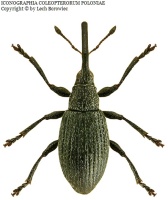
Русские, остановите эту войну! Спасите Свободную Украину!
Russians, stop this war! Save Free Ukraine!
Biodiversity Map
Taxa

Taxa selected by the filter:
Filter in use 
Taxon count: 3
-
Arthropodaphylum
Click to switch
to select orders
and filters > -
Hexapodasubphylum
Click to switch
to select orders
and filters > -
Insectaclass
Click to switch
to select orders
and filters > -
Coleopteraorder
Click to set
as the main taxon
and as a base
← of the left panel > -
Polyphagasuborder
Click to set
as the main taxon
and as a base
← of the left panel > -
Cucujiformiaseries
Click to set
as the main taxon
and as a base
← of the left panel > -
Curculionoideasuperfamily
Click to set
as the main taxon
and as a base
← of the left panel > -
Apionidaefamily
Click to set
as the main taxon
and as a base
← of the left panel > -
Apioninaesubfamily
Click to set
as the main taxon
and as a base
← of the left panel > -
Oxystomatinitribe
Click to set
as the main taxon
and as a base
← of the left panel > -
Catapiinasubtribe
Click to set
as the main taxon
and as a base
← of the left panel > -
Catapiongenus
Click to set
as the main taxon
and as a base
← of the left panel >
PL
YES
name status: valid name
BioMap ID: 1027062
taxon code: 4920
taxonomy checked: YES
-
Filter in use

- Views:
- Overview
- Records
- Publications
- Collections
- Bazy KSIB
- Publ. authors
- Illustrations
- Map
Data on distribution in Poland

Statistics
- Records: 659
- Publications: 135
- Collections: 14
- Publication authors: 82
- Illustrations (iconography): 1
- Photos (specimen/observation): lacking
Taxon description
Gatunek zasiedlający większą część Palearktyki, na wschodzie po środkową Syberię. Występuje w Polsce na całym obszarze, nie notowany dotychczas tylko z Kotliny Nowotarskiej. Występuje na łąkach, trawnikach, przydrożach, w zaroślach i rowach, na uprawach koniczyn i lucerny. Jako rośliny żywicielskie były dotychczas podawane koniczyna łąkowa — Trifolium pratense L. koniczyna pogięta — T. medium L., koniczyna biała — T. repens L. i koniczyna rozdęta — T. fragiferum L. Larwa żeruje i przeobraża się w łodygach powodując na nich niepozorne wyrosła. Przy masowym pojawie może wyrządzać poważne szkody w uprawach lucerny.
Illustrations
... browse
 Catapion
Catapionseniculus
External data sources
- Ostatnie rekordy
-
1099882
 ×
× Apionidae: Catapion seniculus, PL, Białowieski P.N., Białowieża, 1937, leg. A. Gottwald, coll. IBL, Zakład Ochrony Lasu, Sękocin: Gottwald
Apionidae: Catapion seniculus, PL, Białowieski P.N., Białowieża, 1937, leg. A. Gottwald, coll. IBL, Zakład Ochrony Lasu, Sękocin: Gottwald -
1099881
 ×
× Apionidae: Catapion seniculus, PL, Ndl. Białowieża, rez. Głęboki Kąt nature reserve, 1937, leg. A. Gottwald, coll. IBL, Zakład Ochrony Lasu, Sękocin: Gottwald
Apionidae: Catapion seniculus, PL, Ndl. Białowieża, rez. Głęboki Kąt nature reserve, 1937, leg. A. Gottwald, coll. IBL, Zakład Ochrony Lasu, Sękocin: Gottwald -
1098617
 ×
× Apionidae: Catapion seniculus, UA, Tarnopol, Łuczka, 1927, leg. A. Gottwald, coll. IBL, Zakład Ochrony Lasu, Sękocin: Gottwald
Apionidae: Catapion seniculus, UA, Tarnopol, Łuczka, 1927, leg. A. Gottwald, coll. IBL, Zakład Ochrony Lasu, Sękocin: Gottwald -
1098616
 ×
× Apionidae: Catapion seniculus, UA, Tarnopol, Łuczka, 1927, leg. A. Gottwald, coll. IBL, Zakład Ochrony Lasu, Sękocin: Gottwald
Apionidae: Catapion seniculus, UA, Tarnopol, Łuczka, 1927, leg. A. Gottwald, coll. IBL, Zakład Ochrony Lasu, Sękocin: Gottwald -
1098615
 ×
× Apionidae: Catapion seniculus, PL, Bydgoszcz, Bielawki, 1927, leg. A. Gottwald, coll. IBL, Zakład Ochrony Lasu, Sękocin: Gottwald
Apionidae: Catapion seniculus, PL, Bydgoszcz, Bielawki, 1927, leg. A. Gottwald, coll. IBL, Zakład Ochrony Lasu, Sękocin: Gottwald -
1098614
 ×
× Apionidae: Catapion seniculus, UA, Brzeżany, Góra Holica, 1928, leg. A. Gottwald, coll. IBL, Zakład Ochrony Lasu, Sękocin: Gottwald
Apionidae: Catapion seniculus, UA, Brzeżany, Góra Holica, 1928, leg. A. Gottwald, coll. IBL, Zakład Ochrony Lasu, Sękocin: Gottwald -
1070298
 ⊡
⊡ Apionidae: Catapion seniculus, AZ, Talysh Mountains, Yardımlı rayonu, ad Yardımlı, 2013, leg. A. Lasoń
Apionidae: Catapion seniculus, AZ, Talysh Mountains, Yardımlı rayonu, ad Yardımlı, 2013, leg. A. Lasoń -
1064401
 ⊡
⊡ Apionidae: Catapion seniculus, AZ, Talysh Mountains, Yardımlı rayonu, ad Kürəkçi, 2012, leg. A. Lasoń
Apionidae: Catapion seniculus, AZ, Talysh Mountains, Yardımlı rayonu, ad Kürəkçi, 2012, leg. A. Lasoń -
1064399
 ⊡
⊡ Apionidae: Catapion seniculus, AZ, Talysh Mountains, Yardımlı rayonu, ad Kürəkçi, 2012, leg. A. Lasoń
Apionidae: Catapion seniculus, AZ, Talysh Mountains, Yardımlı rayonu, ad Kürəkçi, 2012, leg. A. Lasoń -
1064398
 ⊡
⊡ Apionidae: Catapion seniculus, AZ, Talysh Mountains, Yardımlı rayonu, ad Kürəkçi, 2012, leg. A. Lasoń
Apionidae: Catapion seniculus, AZ, Talysh Mountains, Yardımlı rayonu, ad Kürəkçi, 2012, leg. A. Lasoń - ... more
- Powiązane publikacje
-
Mazur M.A. 2011c. Weevils (Coleoptera: Curculionoidea) of the Stobrawski Landscape Park. Pol. Pismo Ent., 80(2):321-342.
 full text
full text Show records
Show records -
Mazur M.A., Ślusarska E. 2009. Ryjkowce (Coleoptera: Curculionoidea) wybranych zbiorowisk roślinnych Wyspy Bolko w Opolu. Nature Journal, 42:87-97.
 Show records
Show records -
Ruta R. 2007. Chrząszcze (Insecta: Coleoptera) kserotermicznych wzgórz Byszewickich w Dolinie Noteci. Nowy Pam. Fizjogr., 5:49-107.
 Show records
Show records -
Renner K., Messutat J. 2007. Untersuchungen zur Käferfauna der Umgebung von Skwierzyna im westlichen Polen (Wielkopolska). Coleo, 8:16-20.
 Show records
Show records -
Maciejowski W. 2007. Wpływ cech środowiska przyrodniczego na rozmieszczenie wybranych grup chrząszczy (Coleoptera) w południowej części Wyżyny Krakowsko-Częstochowskiej. Wydawnictwo Uniwersytetu Jagiellońskiego. 177 pp.
 Show records
Show records - ... more
- Powiązane zbiory
-
Fodor J.
 Show records
Show records -
ISEZ PAN
 Show records
Show records -
Kuśka A.*
 Show records
Show records -
MiIZ PAN: Tenenbaum Sz.
 Show records
Show records -
Muz. Górnośląskie, Bytom: Mączyński
 Show records
Show records - ... more
- Wykaz powiązanych pozycji
-
Curculionoidea of Poland
 Show records
Show records -
Weevils of the Tatra Mts.
 Show records
Show records







